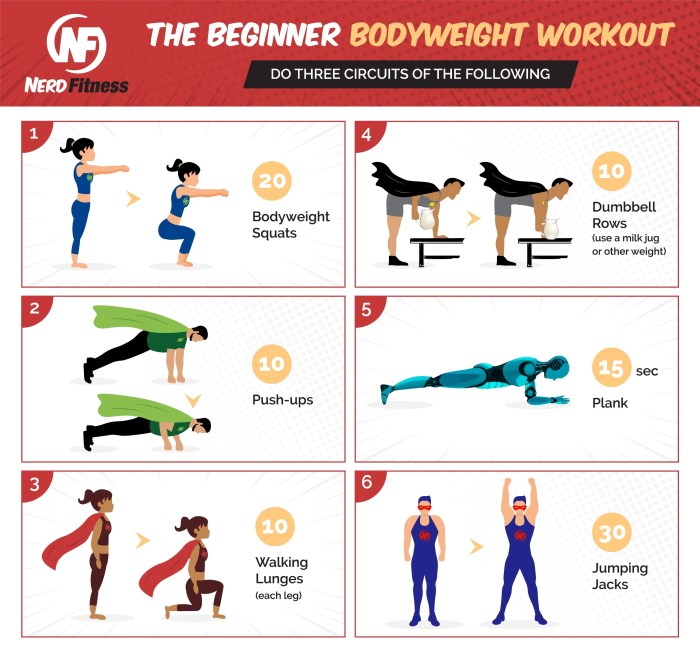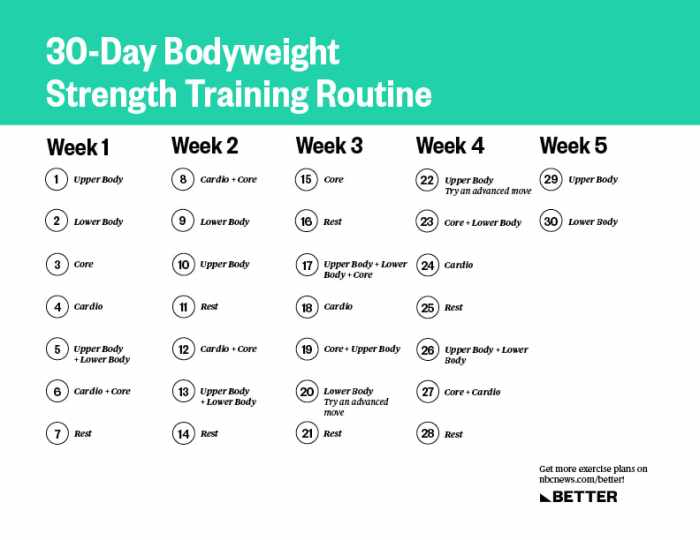Home Workout Routines are all the rage right now, offering a convenient and cost-effective way to stay in shape without hitting the gym. Let’s dive into the world of home fitness and explore the endless possibilities it has to offer.
From the benefits of working out at home to designing a personalized workout plan, we’ve got you covered with everything you need to know to kickstart your fitness journey right from your living room.
Benefits of Home Workout Routines

Exercising at home comes with a plethora of advantages that cater to different lifestyles and preferences. Whether you’re a busy bee or simply enjoy the privacy of your own space, home workout routines offer flexibility and convenience that can help you stay consistent with your fitness goals.
Comparing Home Workouts vs. Gym Workouts
When it comes to choosing between home and gym workouts, the main difference lies in the setting and atmosphere. While gyms provide access to a wide range of equipment and classes, home workouts offer the comfort of working out in familiar surroundings without the hassle of commuting or waiting for machines. Additionally, home workouts can be more cost-effective in the long run as you eliminate the need for a gym membership.
Saving Time and Money
Working out at home saves precious time that would have been spent traveling to and from the gym. With a home workout routine, you can simply roll out of bed and start exercising, cutting out any additional preparation time. Moreover, investing in a few key pieces of equipment or utilizing bodyweight exercises can be more budget-friendly than consistently paying for a gym membership.
Types of Home Workout Routines
When it comes to home workout routines, there are various types of exercises you can do to stay fit and healthy without needing to hit the gym. Bodyweight exercises are a popular choice for home workouts as they don’t require any equipment and can be done anywhere. Let’s take a look at different types of home workout routines and the equipment needed for each.
Bodyweight Exercises
- Squats
- Push-ups
- Lunges
- Planks
- Crunches
Bodyweight exercises are highly effective in building strength, endurance, and flexibility without the need for any equipment.
Cardio Workouts
- Jumping jacks
- High knees
- Burpees
- Mountain climbers
- Jump rope
Cardio workouts are great for improving cardiovascular health and burning calories at home.
Resistance Training
- Dumbbell exercises
- Resistance band workouts
- Kettlebell swings
- Bodyweight exercises with added resistance
Resistance training helps in building muscle strength and toning your body.
Equipment Needed
- Yoga mat
- Dumbbells
- Resistance bands
- Kettlebell
- Jump rope
Having basic equipment like a yoga mat and dumbbells can add variety and intensity to your home workout routines.
Creating a Home Workout Plan
To design an effective personalized home workout plan, it’s essential to consider your fitness goals, available time, and fitness level. Setting specific goals for your home workouts will keep you motivated and focused on your progress. In addition, scheduling and structuring a weekly home workout routine will help you stay consistent and make the most out of your workouts.
Tips for Designing a Personalized Home Workout Plan
- Assess your fitness level: Start by evaluating your current fitness level to determine the intensity and types of exercises that are suitable for you.
- Set specific goals: Whether it’s losing weight, gaining muscle, or improving endurance, setting clear and achievable goals will help you stay motivated.
- Choose the right exercises: Select a variety of exercises that target different muscle groups and include cardio and strength training for a well-rounded workout plan.
- Create a schedule: Determine how many days a week you can dedicate to working out and plan your workouts accordingly.
Importance of Setting Specific Goals for Home Workouts
- Keeps you motivated: Having specific goals gives you something to work towards and helps you track your progress.
- Focuses your efforts: Setting clear goals allows you to prioritize your workouts and tailor your routine to achieve your desired outcomes.
- Measurable progress: By setting specific goals, you can measure your improvements over time and make adjustments to your workout plan as needed.
Scheduling and Structuring a Weekly Home Workout Routine, Home Workout Routines
- Divide your workouts: Allocate specific days for different types of exercises, such as cardio, strength training, and flexibility work.
- Include rest days: Make sure to incorporate rest days into your weekly routine to allow your body to recover and prevent burnout.
- Set a consistent schedule: Choose specific times during the day for your workouts and stick to them to establish a routine.
- Track your progress: Keep a workout journal or use a fitness app to monitor your workouts, track your improvements, and make adjustments to your plan.
Motivation and Consistency in Home Workouts

Staying motivated and consistent with home workouts can be challenging, but with the right strategies, it is definitely achievable. Consistency is key to seeing results and maintaining progress in your fitness journey.
Setting Clear Goals
- Define specific and realistic fitness goals to work towards.
- Break down your goals into smaller achievable milestones.
- Track your progress regularly to stay motivated.
Creating a Routine
- Establish a workout schedule and stick to it.
- Set aside a dedicated space for your home workouts.
- Find a time of day that works best for you and make it a habit.
Mixing Up Your Workouts
- Prevent boredom by trying different types of exercises and routines.
- Incorporate variety to challenge your body and keep things interesting.
- Explore online workout classes or apps for new ideas and inspiration.
Accountability Partners and Apps
- Partner up with a friend or family member for mutual support and motivation.
- Join virtual fitness communities or challenges to stay accountable.
- Use fitness tracking apps to monitor your progress and stay on track.






